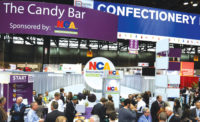
It’s a tough time for confectionery manufacturers, particularly those that use large quantities of sugar. Higher global and U.S. sugar prices have many companies caught in a dilemma. They’d like to pass along higher costs, but find that many retailers are reluctant to accept the price increases.
But just as sugar prices have soared, costs of many other sweeteners have started to come down. And while it’s improbable that the cost of sugar-free sweeteners will ever approach parity with sugar or high fructose corn syrup (HCFS), the price surge certainly has opened up the eyes of many a confectionery manufacturer to what the future may hold.
The most recent report from the United States Department of Agriculture (USDA) notes that although increased sugar cane production in Louisiana has offset lower output in Florida and Hawaii, U.S. sugar beet production has suffered from weather-related consequences. Thus, higher sugar prices remain likely for the remainder of the year, opening up opportunities for new confectionery products using other sweeteners.
For example, according to a USDA Economic Research Service graph, confections account for 16% of all sugar use (excluding HFCS) in the United States. At the same time, new product launches using sucralose and/or nutritive sweeteners, have grown exponentially, soaring from just 1,400 in 2005 to more than 2,200 in 2008, as a Mintel graph illustrated in a 2009 Tate & Lyle presentation.
But as the sweetener supplier points out, the impact of last year’s recession severely reined in the growth surge in such new product launches. Nevertheless, the producers ofSplenda sucralose foresee a tremendous opportunity for increased sweetener usage. Part of that optimism stems from application and delivery.
For example,Splenda, which is a non-nutritive sweetener, is 600 times sweeter than sucrose. Available in micronized, granular and liquid concentrate (25% solids) form, it feature excellent heat and acid stability, thus making it ideal for use in hard candies to replace the sweetness of sugar.
It’s also compatible with a wide range of polyols and bulking agents to develop reduced-sugar and sugar-free confectionery products while delivering pleasant sweetness in finished products. Tate & Lyle has successfully developed jelly candies with reduced sugar and prebiotic fiber by combiningSta-LiteE IIIpolydextrose andPromitor soluble corn fiber withSplenda.
For health- and wellness-oriented confectionery products, the company recently launchedPromitor 60Ssoluble corn fiber withSplenda. It offers a benefit of adding fiber while delivering pleasant sweetness in reduced sugar, “no sugar added” and sugar-free formulations.
The company has also developedKrystar crystalline fructose, a nutritive corn sweetener that is processed from high fructose corn syrup into a pure white, free-flowing crystalline material or pure water white syrup with 77% solids.
Confectioners can develop innovative confectionery products such as instant liquid fondants, starchless moulded jellies and extruded candies usingKrystar. It also exhibits sweetness synergy when blended with many nutritive and non-nutritive sweeteners. In a 50/50 Krystar/sucrose blend, relative sweetness is 128. This allows a 25-28% reduction in sweetener solids without a reduction in sweetness perception.
This sweetener also enhances or intensifies fruit, spice, chocolate, caramel and other sweet flavors in confectionery products. The combination of functional properties found inKrystar - humectancy, high solubility, a low tendency to crystallize and ability to lower water activity - provides excellent benefits in formulating shelf-stable, high solids fruit and cream fillings for filled confections.
One of the leading manufacturers of functional carbohydrates, Beneo-Palatinit, unveiled its Sweets Collection featuring the use of isomalt at the International Sweets & Biscuits/ProSweets fair in Cologne, Germany, earlier this month. This new tool enables the company’s customers to experience and explore a wide range of innovative sugar-free confectionery.
Visitors to the company’s booth were able to view and taste a number of creative candy ideas. One of the inventive examples shown was “Volcano,” a three-layer sugar-free candy combining unusual flavors such as chili and ice. Also, individual and sustained flavor combinations could be tested by candy technologists using the company’s new ‘Pick‘n’Mix’ concept.
Ingrid Willibald-Ettle, Beneo-Palatinit’s head of customer technical service, explained why the company focused its efforts on displaying a Sweets Collection at the international candy gathering.
“Despite the growing confectionery market, sugar candies are experiencing limited growth whereas sugar-free alternatives are constantly growing,” she explains. “The market is such that it’s now even more important for manufacturers to offer innovative ideas in order to guarantee long-term success. The Sweets Collection shows manufacturers our pioneering approach to the sugar-free confectionery market and demonstrates that new, healthy and tasty concepts are feasible.”
Because Beneo-Palatinit’s isomalt is the only sugar replacer on the market that is derived from pure sugar beet with the benefits of being toothfriendly, low glycemic and of low calorie content, it allows tailor-made solutions, the company says. The sugar replacer enhances the brilliance in color and prolongs flavor intensity.
At ProSweets, Willibald-Ettle and Jan Kritzer, manager of consumer intelligence, delivered a presentation highlighting the company’s Candy Innovation Matrix, which provides deeper insight into the company’s ideas for innovative future confectionery concepts. The matrix facilitates innovative and functional developments of sugar-free confectionery with isomalt.
“We have created the Candy Innovation Matrix, which will help customers with new product development by enabling them to explore and successfully blend a range of characteristics using isomalt as a functional ingredient,” Willibald-Ettle says. “This includes combining new flavors, different ways of packaging and functional benefits such as dental health and low-calorie options, together with different shapes, colors and product structures, all with the purpose of developing exciting new and improved candy concepts.
“Therefore, we are committed to assisting customers in the creation of exciting new sugar-free candy concepts,” she adds. “With isomalt, no idea is too outlandish, and with the help of our technical experts, creativity can be limitless.”
Isomalt monograph furthers quality, safety
Edited excerpts from an article by Alexander Schoch, Manager Regulatory Affairs, BENEO-Group.The recent scandals in China involving the manufacture of several contaminated food products that were exported to the United States and other countries only underscore the need to focus even more attention on all food ingredients, food manufacturing processes and food suppliers to ensure that safe food products are reaching consumers everywhere. For U.S. candy and snack manufacturers, one big step in the right direction has been the publication of the first monograph on isomalt in the Food Chemicals Codex (FCC).
The FCC monograph on isomalt is a written standard that characterizes the bulk sugar replacer by providing a description of the ingredient, its identification, and a set of analytical tests and limits that are necessary to ensure appropriate quality and purity levels. The monograph was published in the First Supplement to the Sixth Edition of the FCC, which went into effect May 28 of last year.
Isomalt bulk sugar replacer is widely used in the production of sugar-free confectionery. It replaces sugar in a 1:1 ratio and can be processed in standard production plants without any need to modify the formulation of the processing parameters. Truly an international ingredient, it can be found in more than 2,000 products around the world and is the most widely used ingredient in sugar-free, hard-boiled candies.
It can also be found in a variety of sugar-free chewing gums and every conceivable type of sugar-free candy bar. And with the ongoing worldwide turn to sugar-free food products, the prevalence of isomalt will only increase.
The new FCC monograph on isomalt provides a significant additional quality reference for their customers. What’s more, the new FCC monograph on isomalt will help U.S. candy and snack manufacturers not only with their domestic customers, but with their international customers as well. The reason lies in the nature and scope of the FCC.
The FCC is a vital resource for the food industry in the U.S. as well as the world. It is a compendium that establishes, with public and stakeholder guidance, internationally recognized scientific standards for the identity and purity of food ingredients and supporting test procedures. In this way, it provides quality standards that can be used nationally and internationally to help achieve and maintain food safety. It enables manufacturers of food, food chemicals and food ingredients such as isomalt to comply with standards that have been created and vetted by a highly rigorous and transparent scientific process.
Originally published by the Institute of Medicine from 1966 to 2005, the FCC was acquired by the United States Pharmacopeia (USP) in 2006. As the official national standard-setting body for pharmaceuticals, pharmaceutical ingredients and dietary supplements, the USP is ideally suited to ensure an orderly, timely and transparent scientific process for food ingredient standards, as well. Its well-established revision structure facilitates appropriate stakeholder participation and input, while ensuring the integrity and objectivity of the standard-setting process.
The development of the isomalt monograph exemplifies this process. One of the guiding principles that governed development of the FCC monograph was to institute U.S. standards that correlated with existing international standards, notably the Codex Alimentarius, the purity criteria stipulated by the European Union Sweeteners Regulation and the internationally recognized HPLC method for the determination of isomalt and other polyols in confectionery and other foods (CEN/EN15086:2006).
The Codex Alimentarius is a collection of internationally recognized standards, codes of practice, guidelines and other recommendations relating to food, food production and food safety. Its texts are developed and maintained by the Codex Alimentarius Commission, a body that was established in 1963 by the Food and Agriculture Organization (FAO) of the United Nations and the World Health Organization (WHO).
The commission’s stated aims are to protect the health of consumers and ensure fair practices in the international food trade. The Codex Alimentarius is recognized by the WHO as an international reference point for the resolution of disputes concerning food safety and consumer protection.
In the early 1980s, Beneo-Palatinit, together with experts from its mother company, Suedzucker, drafted an isomalt monograph that was evaluated and approved by the Joint FAO/WHO Expert Committee on Food Additives (JECFA) and became part of the Codex Alimentarius. The current JECFA/Codex Alimentarius monograph on isomalt is available to the public through the FAO Web site,www.fao.org.




